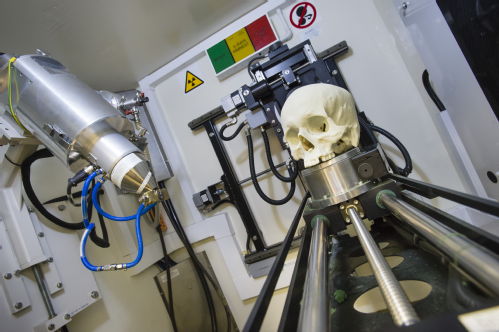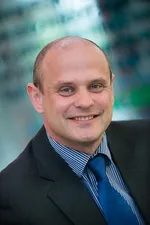Scanning for the truth
Using high resolution digital scanning technology and 3D printing has transformed the way the police collect and present evidence in criminal investigations and resulting trials in recent years. After a number of years of innovative collaboration between West Midlands Police Force and Professor Mark Williams at WMG, University of Warwick, the Forensic Centre for Digital Scanning and 3D Printing was officially launched earlier this year.
There was a little bit of chance involved in Professor Mark Williams' first job for West Midlands Police. He was already working with a knee surgeon to help measure the accuracy of a reconstructed joint. He had made very high resolution images of a cadaver knee, producing image resolutions 1000 times more detailed than a hospital CT scan. This helped the surgeon to perfect his methods before operating on his famous footballer patients.
Professor Williams says: “When the surgeon approached me I considered it a little outside my normal work in automotive research, but well within the capabilities of the lab’s technology, so I was really interested in what we could produce.
“By chance the cadavers used for medical research were stored in the same mortuary as those under investigation by forensics and pathology and that is how news of the very high resolution scans of body parts reached the West Midlands Police.”
Detective Chief Superintendent Mark Payne from West Midlands Police explains: “We knew we needed precision measurement to crack a particularly complicated case which involved matching bone fragments from a dismembered body with the tool potentially used to do it.
“We had heard about the scanning kit that WMG had, and that it was being used in new ways, so we set up the meeting with Professor Williams to see if we could work together.”
How technology helps unlock the truth
In 2014 the force took the grisly case of dismembered body parts found in a suitcase to Professor Williams. They wanted to see if the WMG scanning technology could help answer some questions.
DCS Mark Payne explains: “Having seen the images Professor Williams produced of knee joints and the incredible level of detail they showed, we knew this kind of technology could be applied to minute pieces of evidence in difficult cases.”
Professor Williams comments: “We were able to help the West Midlands Police by examining a charred piece of evidence thought to contain human bone. We discovered that it was a perfect jigsaw fit to another piece of bone in the suitcase, and, using the very high resolution scanning technology, we were able to show the tool marks on both pieces in micro scale (one 50th of a millimetre). These matched the characteristics expected for the type of saw the offender had disposed of, alongside the victim.
“Our 3D printed models of the two pieces were able to demonstrate the evidence to the jury in court.”
DCS Mark Payne of West Midlands Police, continues: “In this case of complex dismemberment, we were able to deliver one of the first examples of micro-CT technology as a forensic radiological method in a UK courtroom.
“Since that first case, we’ve continued to work closely with the WMG team over several years. Their advanced 3D scanning technology has proved crucial in helping us uncover the truth behind some of our most serious crimes. It has undoubtedly played a key role in convicting killers and helped us better understand the circumstances surrounding other deaths.”
Facilities, education and policies
Underpinned by the principles of Metrology (the science of measurement), the Forensic Centre for Digital Scanning and 3D Printing at WMG, University of Warwick, offers a number of techniques and services and supports both research and case work.
Technology available to investigations through the centre include micro computed tomography (micro-CT) and a variety of laser scanners for scanning in the field or lab. There are high definition 3D scanning techniques which not only produce very resolution images but also have the benefit of being non-contact, which means using these techniques limits damage to the evidence. Using the scanned data, the Centre can also produce virtual and 3D printed physical models for use in a court room.
In addition to running these world class facilities, the team has also played a key part in the development of policy – specifically, five Standard Operating Procedures on the handling and transportation of specimens for forensic micro-CT scanning. These have been adopted by Home Office Pathologists and embedded in ongoing training at the College of Policing.
The establishment of the Centre is also driving forward techniques and research areas. Assistant Director of Forensics for WM Police, Michelle Painter, comments:
“This strategic partnership with WMG has enabled police forensics to access state of the art technology to progress investigations. In addition to the homicide cases being delivered through the centre, we are also pushing research boundaries; combining scientific skill, knowledge and history with innovative technology and presentation techniques.
“Additionally, PhD studies have commenced on dismemberment tools and we will be finalising further research projects including scanning fingerprint and footwear marks and assessing damaged digital devices for protected data sources. The research and partnership possibilities are endless and exciting.”
Dealing with difficult facts
The facilities at the centre have been used in some harrowing and high profile cases. For example a high resolution X-ray (micro-CT) scanner was used to scan the rib cage of nine week-old baby Teri-Rae Palmer – a case which made national headlines.
The scanners produced images with one thousand times the detail of a hospital scanner, enabling the expert team to detect two more microscopic injuries which could otherwise have been missed by conventional medical CT scanners.
The evidence produced helped reveal a total of ten injuries of varying ages. 3D renderings of these injuries were shown during trial to provide visual context and support the bone specialist’s expert testimony.
This secured a guilty verdict for the charge of manslaughter for Teri-Rae’s mother.
Professor Williams comments: “State-of-the-art 3D scanning technology allowed us to identify multiple fractures to Teri-Rae’s ribs that had occurred over an extended period of time.
“The ability to produce highly detailed 3D images of these shocking injuries that could be presented in court helped establish the truth and show what had happened. It’s an honour for us to provide critical evidence in cases such as these and to be able to help the police investigate such a tragedy.”
Evidencing the truth
 Professor Williams continues to find the work challenging and significant. He says: “This is important work which at times can be difficult but it is hugely satisfying to be able to produce information which contributes to finding the truth for victims and their families. It is equally important that our research can rule out foul play.
Professor Williams continues to find the work challenging and significant. He says: “This is important work which at times can be difficult but it is hugely satisfying to be able to produce information which contributes to finding the truth for victims and their families. It is equally important that our research can rule out foul play.
“For example in one case where we were tasked with producing technical evidence, a post-mortem examination had revealed two fractures at the base of the person’s skull, only centimetres apart - this did not appear consistent with a fall. At the scene, a damaged front door and signs of a struggle in the hallway meant detectives had suspected foul play.
“We were able to produce a precise 3D printed model of the skull was in our lab which was taken to the scene where it showed perfect matches with the geometry of the door handle. This suggested that the individual had fallen, twice hitting his head. The model therefore helped establish an accidental cause of death.”
The forefront of forensics
Since the first case in 2014, Professor Williams and lead researcher Dr Val Baier – Warwick’s first forensics research fellow – have worked on over one hundred cases with police forces from across the UK.
He adds: “Initially cases trickled in steadily, but now this is a regular and frequent part of the workload, with police regularly presenting this kind of evidence in court. We are proud to establish the Forensic Centre for Digital Scanning and 3D Printing and that we are now fully integrated into the criminal justice system.”
DCS Mark Payne concludes: “It’s vital UK policing is innovative in its use of technology and embraces academic developments. This is a pioneering partnership with WMG and one that puts us at the forefront of police forensics. I’m delighted West Midlands Police has been able to provide funding to sustain and develop the fantastic collaboration between us and WMG.”

Professor Williams and DCS Mark Payne will be talking about their ground breaking collaboration at the British Science Festival, which is being held at the University of Warwick this year.
'Finding a murderer' will take place on Thursday, September 12 from 12:00 - 13:00.
The British Science Festival runs from the 10 -13 September at the University of Warwick.
For more information or to book tickets visit britishsciencefestival.org
Published:
20 July 2019
About:
 Professor Mark Williams is Leader of the Centre for imaging, Metrology, and Additive Technology (CiMAT) at WMG. His role involves the delivery of Metrology, Additive Manufacturing and Visualisation research projects across a wide range of industries.
Professor Mark Williams is Leader of the Centre for imaging, Metrology, and Additive Technology (CiMAT) at WMG. His role involves the delivery of Metrology, Additive Manufacturing and Visualisation research projects across a wide range of industries.
The Forensic Centre for Digital Scanning and 3D Printing opened officially in May. Working in partnership with West Midlands Police, the team uses digital prototyping tools and techniques to generate forensic evidence to support the Criminal Justice System. Prof Williams and the team have provided pivotal evidence for over 100 homicide investigations across 13 Police Forces in the UK and abroad.
Images:
Top: Prof Mark Williams (L) and DCS Mark Payne from WM Police study one of the very high resolution images produced in the Forensic Centre at WMG.
Bottom: An example of a 3D rendered artefact which can be used as evidence in court.
Terms for republishing
The text in this article is licensed under a Creative Commons Attribution 4.0 International License (CC BY 4.0).
Share


